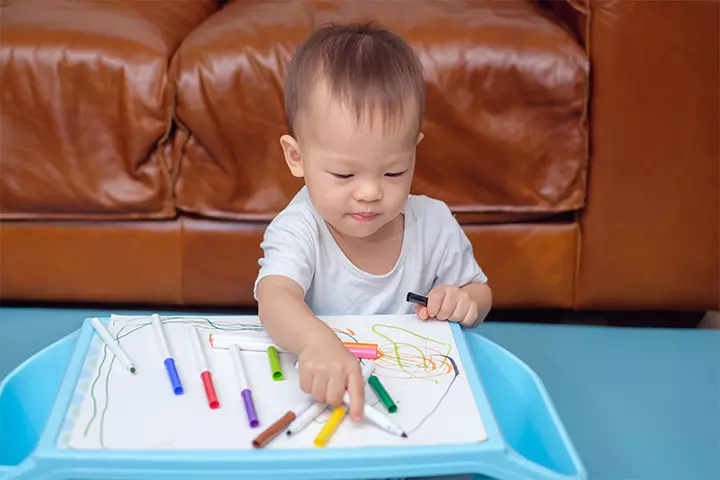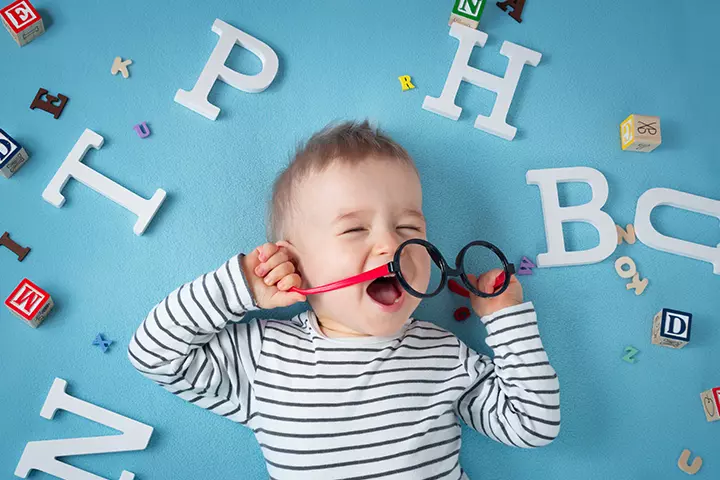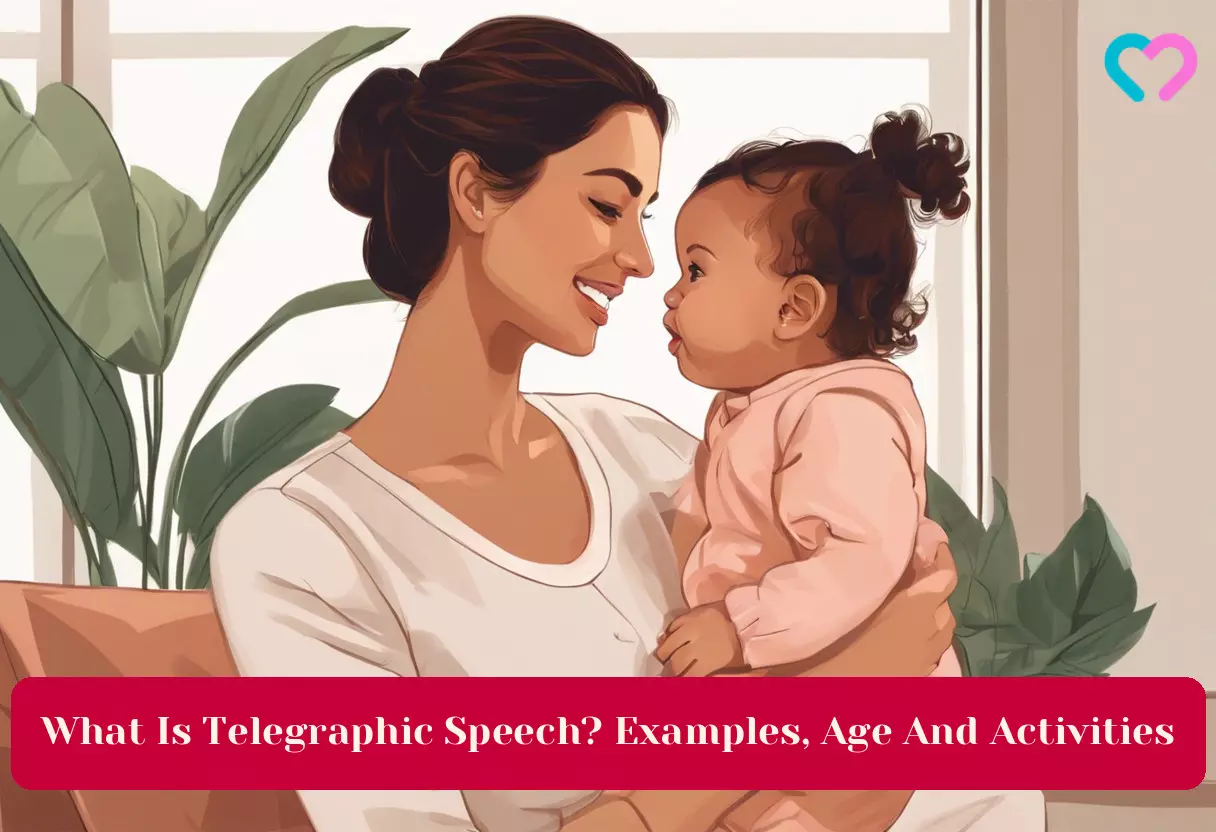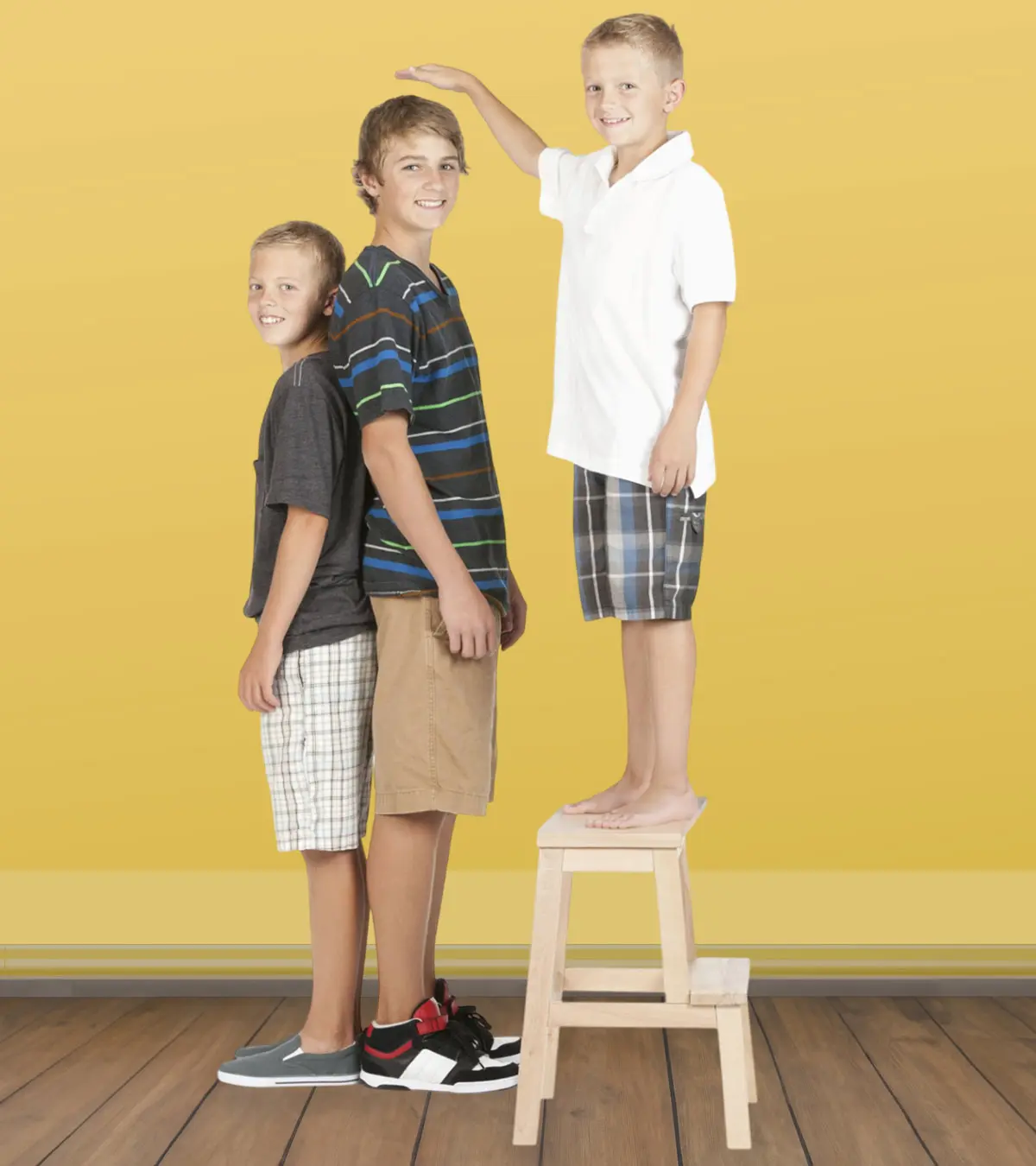
Image: Shutterstock
Telegraphic speech refers to the simple two-word sentences your toddler says when they begin to communicate.
It is an important stage of language development in children.
Babies may babble for months before saying their first words. However, after uttering their first words, they need to complete many developmental milestones before they can speak a complete sentence correctly.
Read on to know what telegraphic speech is, when it occurs, and how to encourage a toddler to speak.
Key Pointers
- Telegraphic speeches are broken phrases or sentences.
- These defy grammar rules but help them communicate and gradually transition into correctly structured sentences.
- Activities such as small conversations or telegraphic questions can aid their language development.
What Is Telegraphic Speech?
When toddlers are developing speech, they tend to speak multi-word sentences with only the key content words. This is called telegraphic speech(1). Telegraphic messages are a form of speech simplification that simplifies the language and disregards grammatical rules. This form of speech is a part of the normal language acquisition process (2). Early linguistic patterns, such as telegraphic speech, play a crucial role in facilitating the advancement of lexical development.
Telegraphic sentence formation is similar to the short messages consisting of only keywords sent via telegraph in the olden times. Hence, this condensed speech pattern of babies and toddlers is referred to as telegraphic speech.
 Do remember
Do rememberExamples Of Telegraphic Speech
The telegraphic speech can comprise two-word and multiple-word sentences. Here are a few example sentences that a toddler or baby may speak as part of their telegraphic speech.
- Dada go
- I sleepy
- Where mommy

- I go potty
- More water
- Plate down
At What Age Does Telegraphic Speech Begin?
Expressive language development progresses through distinct stages. Children generally start telegraphic speech between the ages of 24 and 30 months. This comes after the two-word stage that occurs at 18-24 months (3).
The two-word stage is preceded by the holophrastic stage, where babies speak single words to express meanings similar to complete sentences. The stage occurs between 9 and 18 months.
Children then move to the two-word stage, where they speak brief two-word utterances that convey semantic relationsiAn association between two words that convey the same meaning in a given context for a sentence. between the two words. From here, toddlers progress to the telegraphic stage, speaking sentences with two words and more.
Features Of Telegraphic Speech
Here are a few notable features of a toddler’s telegraphic speech(4).
- Only crucial sentence elements are present
- The order of elements is mostly correct
- Words are linked together, but it cannot be considered a proper sentence due to limited word use
- Grammatical elements, such as articles (the, a), prepositions (on, in), auxiliaries (is, are), prefixes, pronouns, and conjunctions, are often missing
- Tense morphemes, such as ‘ing,’ ‘ed,’ ‘s,’ and plurals are mostly absent
Why Is Telegraphic Speech Important For Development?
Telegraphic speech is one of the milestones of language development.
Here is how it helps toddlers.
- Helps in understanding sentence formation: When toddlers use telegraphic speech, the words are generally in the correct order. They also use nouns and verbs. While they may not understand grammar, they learn sentence construction at this stage. This helps them become adept at using structurally correct sentences gradually. Thus, the use of telegraphic speech has a positive effect on language development.
- Useful in communication: At this age, children understand their needs and surroundings better. They want to share their requirements and experiences with their parents. Inability to properly communicate can be frustrating for them. Telegraphic speech helps toddlers express their thoughts and feelings effectively.

- Useful in transitioning to the next stage of language development: Practicing sentence construction can help toddlers transition to the next stage of language development easily. Within the next few months, they understand all commands and expand their vocabulary. Soon they start figuring out complex sentence structures and slowly learn to speak grammatically correct sentences.
Telegraphic Speech Activities For Toddlers
A few activities can help children practice their telegraphic speech.
1. Coloring and conversations

Buy a coloring book suitable for toddlers. It should have different elements for coloring purposes. Guide the toddler in the process of coloring by asking the right questions. This can encourage them to express themselves and experiment with telegraphic speech.
For instance, if it is a nature scene with animals, trees, and sky, ask the child, “What is that?” by pointing toward a particular object in the book. If they give a one-word answer such as “tree,“ say the full sentence, “Yes, that is a tree.”
You can ask a follow-up question before they start coloring, such as, “What should be the color of the tree leaves?” If the child gives a one-word answer “green,” speak the complete sentence by saying, “The color of the tree leaves is green.” In case they answer using telegraphic speech, show appreciation.
2. Telegraphic story questions
You can consider reading stories as one of the language development activities for toddlers. You can tell your own stories or read from a book. This helps create word associations in the toddler’s mind.
Ask them questions in between to increase their interest and help them absorb more information about the language. For instance, if it is a story about a bird who sings, you can ask, “Who sings?” If they answer “bird” or state the bird’s name, offer praise. If they give one-word answers or do not answer at all, you can say, “The bird (or its name) sings.”
Encourage discussion of the story once you are done reading it.
 Experts say
Experts say3. Whose-What? game
Fun games can help toddlers pick new words faster and remember them better. In this game, collect pictures of everyone in the house. Gather personal items belonging to each of these individuals in a box. Keep the box and pictures pile in front of the child. Choose any one item from the box and ask the child, “Whose (item name) is it?” Ask the child to select the photograph of the person it belongs to and encourage them to say the person’s name out loud.
4. Follow the leader
In this game, the follower has to copy whatever the leader does and speaks. Whenever you are out with your toddler, point out anything and explain it. For instance, point to a bike and say, “A bike.” The toddler has to point to the same object and repeat the sentence after you. Encourage your child to take the next turn and describe any object they see. In each of your following turns, continue to add more words while describing the objects to help the toddler learn new words.
How To Encourage Telegraphic Speech?
The following techniques can be used to encourage telegraphic speech in toddlers.
1. Model correct language
Research hypothesizes that children can pick up language by listening to other people speak around them and practicing similar sounds (5). They can use these cues to figure out the linguistic units. So, it is important to model correct language (6).
Parents can model correct language by speaking complete sentences even if the toddler relies on telegraphic speech (7). Use the correct grammar and pronunciation even if the child says something wrong (8). For instance, if the toddler says, “I pay” while picking the toy, say the correct sentence, “Yes, I understand you want to play.”
2. Respond to gestures

Babies in holophrastic and two-word stages of communication often use gestures in conjunction with talking. For instance, they may use a specific gesture when they want a specific toy or when hungry. Respond to the gestures by fulfilling their need or intent. For instance, if the toddler wants to play and uses a gesture or points at the toy, say, “Okay, let’s play” before bringing the toy. The age-appropriate use of gestures can help early language development, laying the foundation for telegraphic speech(9)(10).
3. Take the help of fun activities
You can use fun activities in the following way to improve a toddler’s telegraphic speech(11).
- While playing with building blocks or other toys, use words to describe what is happening. Teach them key elements of a sentence, such as verbs and adjectives, during the activity. Use a new word every time you play.
- As you go about your activities for the day, explain what you are doing, such as cleaning, cooking, or working. Indicate and explain things the toddler senses around him/her in a simple language. Teach them the names of different objects in the house and outdoors.
- Make language learning fun with music. The beats and inflection of music can help toddlers understand different syllables. You can use actions in line with the song’s lyrics to help the toddler learn new words better.
 Do remember
Do rememberHow Many Words Should A Toddler Say?

A toddler is a child aged between one and three years(12). The words they understand and speak can change as per their age(13)(14).
- 12-17 months: The toddler has a vocabulary of four to six words. They can name a person or object using about two to three words, but the pronunciation might be unclear. They understand the meaning of simple phrases and try to emulate simple words they hear.
- 18-23 months: A toddler in this age group has a vocabulary of 50 words, albeit with an unclear pronunciation. They begin to combine words and speak using two-word combinations, thereby forming two-word phrases. Toddlers in this age range can indicate a few body parts when quizzed and answer simple ‘yes and no’ questions. Use of pronouns, such as mine, her, and his, can be observed.
- 24-36months: Toddlers can use at least 100 words by the age of two years. A toddler between the ages of two and three years can use three-word sentences and answer simple questions. They can also understand prepositions, such as on and in.
What Is The Next Stage?
The telegraphic speech stage ends at the age of 30 months, and toddlers gradually begin to speak complex, structured sentences.
Their vocabulary increases quickly, and they pick up new words every day between 30-42 months. At 36 months, many children start using functional morphemesiWords that do not carry an independent meaning but may modify or link a given word to a given sentence. . They may use synchronized and embedded sentences such as “I like mummy because she is pretty.”
Children begin to comprehend almost everything they hear. At about 42 months, they are capable of doing the following(15).
- Uttering “Wh” type questions such as “What did you eat?”
- Understanding and using embedded clausesiA combination of words that make up a meaningful sentence, having a subject and predicate. such as “Julie, who is my friend, likes playing with me”
- Comprehending and applying relative clauses in sentences such as “This is the juice that mummy drinks every day”
- Forming reflexive pronounsiA pronoun used to describe an action a person usually does to or for themselves. such as “I hurt myself yesterday”
Frequently Asked Questions
1. How can telegraphic speech be used in language therapy for children?
A certified language therapist specializing in children can use telegraphic speech to help children build their initial basic vocabulary, promote taking turns in conversation, and encourage verbal expression. The simple and non-complex nature of telegraphic speech can be beneficial in laying the foundation of speech in children with language disorders.
2. Can telegraphic speech indicate a developmental disorder or delay?
Telegraphic speech is a normal event and not a sign of a developmental disorder. However, if your child continues to use it even after the age of 30 months or the child does not learn new words, speak to a doctor or a pediatric speech therapist.
3. How can speech therapy help children who struggle with telegraphic speech?
Speech therapy for kids helps them overcome their language and speech problems through games and learning activities (17). Thus, if a child faces problems with telegraphic speech, a speech-language pathologist will evaluate the exact problem over multiple sessions and devise a customized plan for your child. The plan may include reading from flashcards, word lists, or games to improve speech and fluency or writing words on different textures (18).
4. What are some red flags that I should look out for when it comes to telegraphic speech?
If your toddler is two years old and there is still a limited or complete absence of grammatical markers in telegraphic speech, it may be considered a red flag (19). Furthermore, if they consistently rely on specific words to communicate different needs, it is advisable to consult a specialist.
Telegraphic speech is an important step that leads to language development in children. Children often take at least five to six years to master their language. Meanwhile, telegraphic speech helps them to communicate and understand the formation of sentences. Some activities that can help children practice telegraphic speech are asking questions and playing games. Interacting with other children, teachers, and parents also gives them good exposure to the language. Therefore, speak as much as you can with your children and encourage them to express more.
Infographic: Effective Ways To Encourage Telegraphic Speech In Children
Your little one saying “Where Mommy?” is an example of a telegraphic speech. This might not be a complete or grammatically correct sentence, but it is surely a big step toward their language development. Explore the infographic below for practical ways to encourage telegraphic speech in your child.

Illustration: Momjunction Design Team
 Point to consider
Point to considerIllustration: What Is Telegraphic Speech? Examples Age And Activities

Image: Stable Diffusion/MomJunction Design Team
Your toddler is trying to speak and you may help them by understand telegraphic speech. In this video, learn about telegraphic speech, the process of using only the most essential words to communicate a message.
References
1. Cheryl Smith Gabig Telegraphic Speech Encyclopedia of Autism Spectrum Disorders; Springer
2.Courtney E. Venker et al., Parent Telegraphic Speech Use and Spoken Language in Preschoolers With ASD; NCBI (2015)
3.Bertaria Sohnata Hutauruk Children First Language Acquisition At Age 1-3 Years Old In Balata; IOSR Journal Of Humanities And Social Science (2015)
4. The syntactic development in the earlier stages of children’s first language acquisition; Linnaeus University
5. Learning Language; University of Georgia Extension
6. Activities to Encourage Speech and Language Development; American Speech-Language-Hearing Association
7. Ten Principles of Grammar Facilitation for Children With Specific Language Impairments; American Journal of Speech-Language Pathology
8. Language Development; Utah Education Network
9.Seyda Ozcaliskan and Susan Goldin-Meadow Gesture is at the cutting edge of early language development; NCBI (2005)
10. How Do Gestures Help Your Child’s Language Development?; The Early Learning Institute
11. 5 Great Language Development Activities; NAPA Center
12. Ages & Stages; American Academy of Pediatrics
13. Age-Appropriate Speech and Language Milestones; Stanford Children’s Health
14. Age-Appropriate Speech and Language Milestones; Children’s Hospital Philadelphia
15. Linguistic Stages in First Language Acquisition: A Critical Analysis; International Journal Of English Language
16.Learning a Second Language is Easier for Children, But Why?; Penn State University
17.Pediatric Speech Therapy; HSS.edu
18.Signs your child should see a speech therapist; Hackensack Meridian Health
19.Intellectual Disability and Language Disorder; NCBI
Community Experiences
Join the conversation and become a part of our nurturing community! Share your stories, experiences, and insights to connect with fellow parents.
Read full bio of Dr. Neema Shrestha
Read full bio of Shivali Karande
Read full bio of Rohit Garoo
Read full bio of Vidya Tadapatri





















